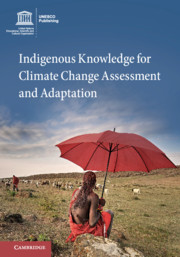Book contents
- Indigenous Knowledge for Climate Change Assessment and Adaptation
- Indigenous Knowledge for Climate Change Assessment and Adaptation
- Copyright page
- Contents
- Contributors
- Foreword
- Acknowledgements
- Abbreviations
- 1 Indigenous Knowledge for Climate Change Assessment and Adaptation: Introduction
- Part I Knowing our Weather and Climate
- Part II Our Changing Homelands
- Part III Confronting Extreme Events
- Part IV Sources of Indigenous Strength and Resilience
- Index
- References
Part II - Our Changing Homelands
Published online by Cambridge University Press: 13 September 2018
- Indigenous Knowledge for Climate Change Assessment and Adaptation
- Indigenous Knowledge for Climate Change Assessment and Adaptation
- Copyright page
- Contents
- Contributors
- Foreword
- Acknowledgements
- Abbreviations
- 1 Indigenous Knowledge for Climate Change Assessment and Adaptation: Introduction
- Part I Knowing our Weather and Climate
- Part II Our Changing Homelands
- Part III Confronting Extreme Events
- Part IV Sources of Indigenous Strength and Resilience
- Index
- References
- Type
- Chapter
- Information
- Publisher: Cambridge University PressPrint publication year: 2018



